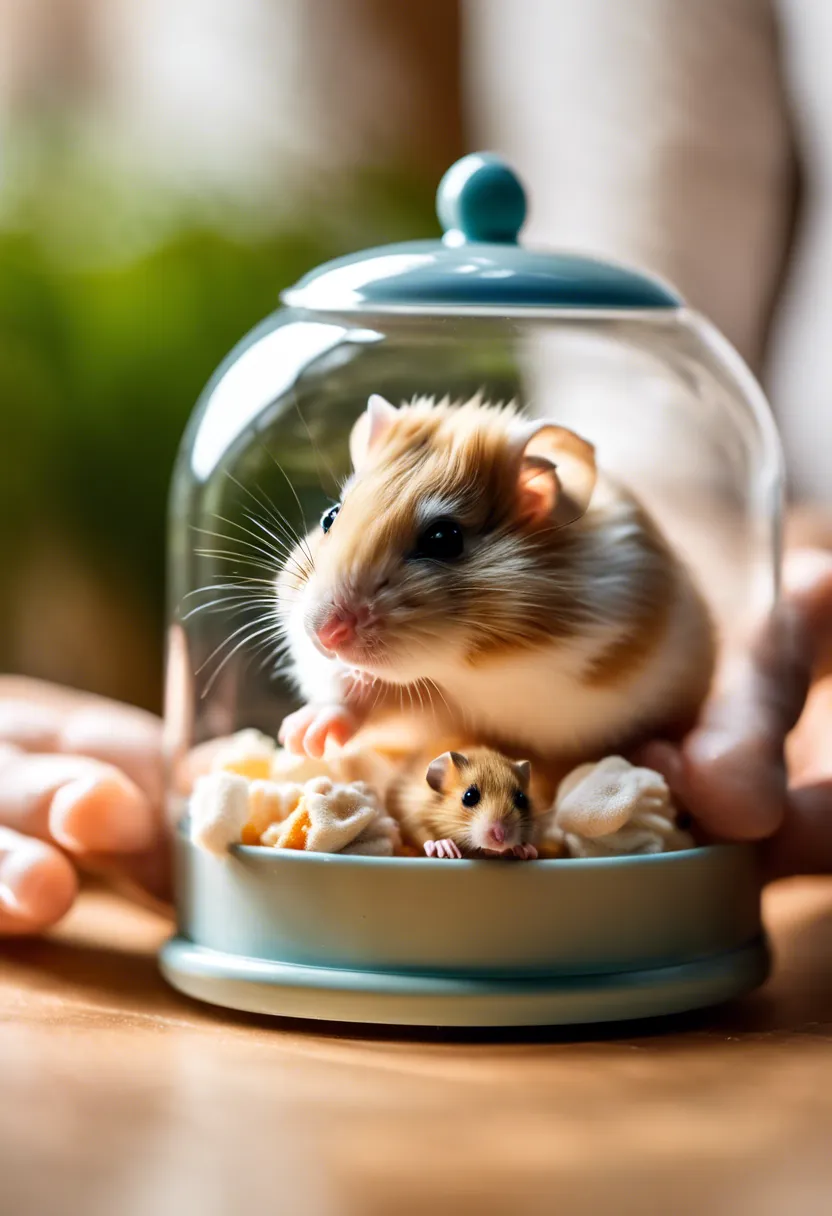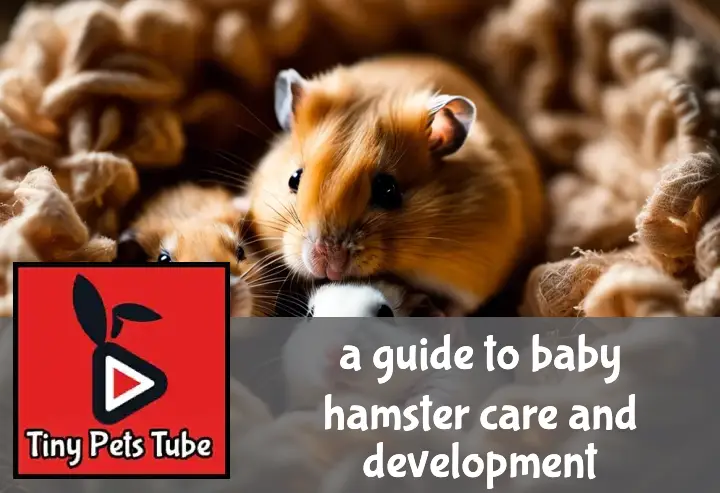Ever found yourself “aww-ing” over the sight of a cute, tiny hamster and thought about bringing one home? Well, you’re not alone! But hold your horses – or should I say, hamsters? If you’ve decided to embark on this journey of baby hamster care and development, it’s essential to arm yourself with all the right information.
In this guide, we’ll cover everything from setting up the perfect crib for your tiny furball to ensuring they grow up healthy and happy. So buckle up and let’s dive into the fascinating world of baby hamsters. Keep reading about a guide to baby hamster care and development!
Key Takeaways
- Understanding Baby Hamsters: It’s important to know their life cycle, how to recognize their age, and the differences between baby and adult hamsters.
- Preparing for Your Baby Hamster: Choose the right cage and bedding, select appropriate toys and accessories, and set up a safe environment. Remember, it’s not just about comfort but safety too!
- Feeding Your Baby Hamster: Understand the nutritional needs of a baby hamster, choose the right food, and follow an appropriate feeding schedule. Don’t worry if your little furball seems to eat a lot – they’re growing!
- Health Care for Your Baby Hamster: Be aware of common health issues in baby hamsters. Regular check-ups are crucial, as is knowing what to do in an emergency. Yes, even our tiny friends can have big health scares.
- Socialization and Handling of Your Baby Hamster: Learn when you can start handling your baby hamster safely and how to socialize them with other pets. Remember that every creature has its own unique personality – including hamsters!
- Monitoring Development and Growth: Keep track of physical changes, observe behavioral development, and address any developmental concerns promptly. You’ll be amazed at how quickly these little critters grow!
- Grooming Your Baby Hamster: A step-by-step guide will help you keep your hamster clean without causing stress or harm. Believe it or not, even hamsters like a good spa day!

Understanding Baby Hamsters
Diving into the world of baby hamster care and development is like opening a book filled with tiny, fluffy mysteries. From their early days to becoming curious little explorers, there’s so much to learn about these pint-sized pets.
The Life Cycle of a Hamster
Hamsters kick off their journey in this world as blind, hairless babies, relying entirely on their mom for warmth and nutrition. In just about a week, they start sprouting fur and by two weeks, their eyes are wide open, ready to take in their surroundings. This is when the real fun begins! Weaning young hamsters off their mother’s milk comes next, introducing them to solid food as they step into adolescence. Each phase, from newborn hamster care to dealing with the antics of an adolescent hamster, brings its own set of challenges and joys. Before you know it, they’re all grown up – well, in hamster terms – reaching adulthood around 8 to 10 weeks old. But let’s not forget; the lifespan of hamsters isn’t very long, so every moment is precious.
Recognizing a Baby Hamster’s Age
Guessing a baby hamster’s age might feel like trying to solve a puzzle without all the pieces. However, certain clues can help you get pretty close. Initially, baby hamsters are bald and pink but don’t worry; they start showing signs of fluffiness within a week. By keeping an eye on these week-by-week growth changes in baby hamsters, you can roughly estimate their age. For instance, if you spot a tiny furball starting to nibble on solid food or attempting its first wobbly steps out of the nest, chances are it’s around 2-3 weeks old. These developmental milestones in hamsters are key indicators for adjusting your caring for different aged baby hamsters approach accordingly.
Differences Between Baby and Adult Hamsters
Spotting the difference between junior fluffballs and their adult counterparts isn’t just about size; it’s noticing how their needs evolve too. Baby hamsters have diets that differ significantly from adult ones; they require more proteins to support their rapid growth. And while babies spend most of their time eating or sleeping (living the dream!), adults show more complex behaviors – from territorial disputes to nightly escapades on the wheel. Understanding these distinctions is crucial for providing proper nourishment and environment at each stage of hamster growth. As they grow older and transition from nurturing young to caring for matured hammers , adapting your approach ensures your furry friend thrives at every stage of life.
Preparing for Your Baby Hamster
Getting your space ready for a tiny, furry bundle of joy is crucial in baby hamster care and development. It’s all about creating a cozy, safe haven that encourages growth and happiness.
Choosing the Right Cage and Bedding
When it comes to setting up shop for your baby hamster, picking the right cage is like choosing a luxury apartment for a tiny furball. You want something spacious enough so they can scamper around without bumping into walls. The best cages for baby hamsters are those with plenty of room for exploration but with bars close enough together to prevent escape attempts.
Next up, bedding. Think of this as choosing the perfect mattress. Safe bedding materials are crucial because you don’t want anything that could harm your little buddy if they decide it looks tasty. Paper-based or aspen shavings are top-notch choices, offering comfort and excellent absorbency. They create a comfortable hamster habitat where dreams of endless tunnels and food stashes come true.
Selecting Appropriate Toys and Accessories
Toys aren’t just toys when it comes to baby hamsters; they’re essential tools for living their best life. A well-chosen wheel offers endless hours of cardio, while stimulating hamster toys like tunnels mimic their natural environment, keeping them physically active and mentally sharp.
But wait, there’s more! Chew toys are not just about fun; they’re about dental health too. Opting for safe hamster accessories, like untreated wooden chews or hard cardboard tubes, can help keep those tiny teeth in tip-top shape. Remember, every toy is an opportunity to enrich your baby hamster’s life significantly.
Setting Up a Safe Environment
Creating a haven starts with knowing what dangers to dodge. Ensuring the cage is free from sharp edges or small gaps is step one in creating a safe habitat for baby hamsters. Then think about layout – you want to design a space that encourages exploration but doesn’t put your furry explorer at risk.
Avoid common hazards by securing all accessories firmly and ensuring there’s no risk of tipping or falling. When arranging play areas outside the cage, consider enclosing the space to prevent any adventurous escapes. Ultimately, designing secure environments isn’t just about safety; it’s about crafting spaces where small pets can thrive without worry.

Feeding Your Baby Hamster

When it comes to baby hamster care and development, understanding their dietary needs is crucial. Let’s dive into what makes a baby hamster’s belly happy and healthy.
Understanding Nutritional Needs of a Baby Hamster
Baby hamsters are like tiny athletes in training; they need the right fuel to grow strong and healthy. Unlike their adult counterparts, these little furballs require more protein to support their rapid growth. Think of protein as the building blocks for all that scampering and exploring they do.
But it’s not just about protein; dietary fiber plays a starring role too. It keeps their tiny digestive systems running smoothly, preventing any unwanted tummy troubles. So, when you’re planning your pet’s menu, remember it’s all about balance. A mix of essential nutrients for baby hamsters ensures they’ll grow up to be the healthiest and happiest hammies on the block.
Choosing the Right Food
Picking the perfect grub for your baby hamster can feel like you’re navigating a mini-maze yourself. But fear not! High-quality commercial foods designed specifically for young hamsters are your best bet. These blends have done the nutritional legwork for you, packing in all those vital nutrients.
However, variety is the spice of life—even for hamsters! Introducing fresh fruits and veggies can add some excitement to their diet but proceed with caution. Too much can lead to an upset stomach, so it’s all about moderation. Remember, finding the best commercial foods for young hamsters that also allow room for a bit of fresh produce is key to dietary success.
Feeding Schedule and Portions
Now, let’s talk timing and size—nope, not about watches or shoes, but feeding schedules and portions! Baby hamsters do best on a consistent feeding routine; think small meals twice a day. This helps avoid overindulging while ensuring they’re getting enough fuel for growth.
Portion control is paramount; too much food can lead to obesity (yes, even in such tiny creatures), while too little can hinder their development. A good rule of paw? Offer an amount they can finish within 24 hours, ensuring fresh food at each mealtime without encouraging hoarding behavior. Establishing this routine early on sets the stage for a lifetime of healthy eating habits.
Health Care for Your Baby Hamster
Taking care of a baby hamster’s health is crucial for its development. Let’s dive into how you can keep your little furball happy and healthy.
Common Health Issues in Baby Hamsters
Baby hamsters are adorable, but they’re also prone to some health issues that can make any pet parent anxious. Wet tail disease is a common ailment among these tiny critters, characterized by diarrhea and can be fatal if not treated promptly. It’s like the flu for us but way worse for them.
Then there’s the sneezy problem of respiratory infections. If your hamster starts sounding like it’s trying out for a role in a sniffles commercial, it might be time to check for this issue. And let’s not forget about hamster mite infestation – sounds gross because it is! These tiny pests can make your hammy’s life miserable.
Preventing these illnesses involves keeping their living area clean and watching out for early symptoms. Remember, a clean cage is a happy cage!
Regular Check-ups and Vaccinations
Believe it or not, even tiny creatures like baby hamsters benefit from regular vet visits. It might seem like overkill taking such a small pet to the vet, but veterinary care for hamsters plays a big part in preventing diseases before they start.
There isn’t exactly a long list of baby hamster vaccinations schedule, mainly because vaccines for them are pretty limited. However, discussing preventive care with your vet can help dodge common health bullets and keep your mini buddy bouncing around happily.
Regular check-ups are the secret sauce to catching any potential health issues early on. Think of it as investing in peace of mind for both you and your furry friend.
Emergency Care: What to Do
No one likes emergencies, especially when it involves our pint-sized pets. But knowing what to do when faced with one can be a game-changer. First off, having an emergency treatment plan for pet rodents handy is crucial. This means knowing who to call (your vet!) and what immediate steps you can take at home.
If your hamster suddenly seems ill or injured, gentle handling and keeping them warm and quiet is key while you seek professional advice. Avoid playing doctor – no googling DIY treatments! Instead, focus on providing comfort until you can get expert help.
Remember, being prepared with basic first aid knowledge for sick hamsters could significantly impact the outcome of any emergency situation involving your fluffy companion.
Socialization and Handling of Your Baby Hamster
Getting your fluffy little friend used to human touch and other pets around the house is a big deal in baby hamster care and development. Let’s dive into how you can make this journey smoother for both of you.
When to Start Handling a Baby Hamster
The best time to start handling your baby hamster is around 2 weeks after they’ve opened their eyes. This period is crucial for their baby hamster development as it lays the foundation for their social skills. Before this age, it’s important to let them bond with their momma and siblings without too much human interference.
Handling them too early can lead to stress, while waiting too long might make them shy or fearful of contact. Stick to gentle touches at first, gradually increasing handling time as they get used to you. Remember, patience is key in building trust with these tiny creatures.
Techniques for Safe Handling
First things first, always wash your hands before handling your hamster to avoid transferring any scents or oils that might stress them out. To pick them up, scoop them gently from below rather than grabbing from above—this mimics how they would interact with each other in the wild and feels less threatening.
Hold them close to your body or a soft surface so if they wriggle free, they won’t have far to fall. Keep sessions short at first, about 5 minutes, gradually increasing as your hamster becomes more comfortable with you. These moments are golden opportunities for bonding and establishing trust.
Socializing Your Baby Hamster with Other Pets
Introducing your baby hamster to other pets should be done with utmost care and patience. Start by allowing your pets to sniff each other under supervision through the safety of the hamster’s cage bars or a transparent enclosure. This helps minimize stress while letting them get acquainted with each other’s scents.
Always monitor these interactions closely and never leave your baby hamster unsupervised with larger pets—even the most well-behaved dog or cat might see them as prey due to their natural instincts. Gradual and controlled exposure is key in creating harmonious multi-pet households without causing undue stress on your tiny furball.
Monitoring Development and Growth
Keeping an eye on your fluffy friend’s journey from a tiny furball to a full-grown hamster is not just exciting but crucial for their well-being. Understanding the baby hamster care and development process involves more than just watching them grow; it’s about ensuring they’re hitting all the right milestones along the way.
| Age (weeks) | Physical Changes | Behavioral Changes | Expected Weight Range (grams) |
|---|---|---|---|
| 0-1 | Eyes and ears closed, pink skin, very little fur | Nursing, little movement | 2-5 |
| 1-2 | Fur starts to grow, eyes begin to open | More active but still stays close to mother | 5-10 |
| 2-3 | Eyes fully open, ears open, more distinct coloring | Begins to explore surroundings, starts eating solid food | 10-20 |
| 3-4 | Fully furred, looks like a miniature adult | Weaning from mother’s milk, more independent | 20-30 |
| 4-5 | Growth in size but not yet adult-sized | May start showing interest in wheel running | 30-40 |
| 5-6 | Nearing adult size, sexual maturity begins | Increased curiosity and independence, possible aggression if housed with same-sex siblings post-weaning | 40-50 |
| 6+ | Reaches adult size | Adult behavior patterns established | Female: 100-150 / Male: 85-130 |
Note: The expected weight range can vary significantly depending on the breed of hamster. Always consult with a veterinarian for the most accurate and personalized advice regarding your pet’s growth and development.
Tracking Physical Changes
When it comes to baby hamsters, every gram counts. Literally. Monitoring your baby hamster’s weight gain is like watching a reality TV show where every episode reveals something new and exciting. It’s one of those clear signs that they’re gobbling up their dinner and heading towards a healthy adulthood. But hey, it’s not just about tipping the scales; let’s talk fur development. Initially, these little critters might look more bald than you’d expect, but soon enough, they’ll start flaunting their fur coat like they’re walking the runway at Hamster Fashion Week. These physical changes are key indicators of signs of healthy growth in hamsters, so keeping an eye out for steady weight gain and that lush fur coming in means you’re on track with your baby hamster care and development.
Observing Behavioral Development
Now onto the soap opera part of baby hamster care and development: behavioral development. One day they’re all shy and reserved, barely peeking out of their bedding, and the next thing you know, they’re zooming around like tiny furry race cars. Increased activity levels? Check. That means your baby hamster is feeling pretty darn good about life. And when you see them starting to socialize with their siblings or even showing curiosity towards you, it’s like winning a gold medal in pet parenting. These moments are not just adorable but are crucial behavioral milestones in baby hamsters that indicate everything is A-OK in Hamsterville.
Addressing Any Developmental Concerns
But what if things don’t seem right? Maybe your mini munchkin isn’t gaining weight as expected or seems more like a hermit than a social butterfly. First rule: don’t panic! Not all baby hamsters read the same growth chart before coming into this world. However, knowing when to wave the white flag and consult a vet for your hamster is key to addressing any developmental concerns early on. Vets are like detectives for health issues; they can spot clues you might miss and help ensure your furry friend gets back on track to becoming a happy, healthy adult hamster. Remember, early intervention can make all the difference when it comes to ensuring healthy growth in young hamsters.
Step-by-Step Guide to Grooming Your Baby Hamster
Grooming your baby hamster is not just about keeping them looking cute and cuddly; it’s a crucial part of their care that ensures they stay healthy and happy. Unlike their adult counterparts, baby hamsters require a more delicate touch and specific grooming techniques to avoid stress and injury. Let’s dive into the nitty-gritty of baby hamster grooming.
First off, you’ll want to get your hands on some pet-safe grooming tools. A soft-bristled brush is perfect for gentle brushing techniques that won’t irritate their sensitive skin. Start by lightly brushing the fur to remove any loose hair or dirt, ensuring you’re always going with the grain of their coat to keep them comfortable.
Next up is nail trimming, which can be a bit tricky given how tiny those nails are! Safe nail trimming for hamsters involves using a special small animal nail clipper and only taking off the tips to avoid cutting into the quick. If you’re nervous about this step, it might be worth seeking out professional pet grooming services for help.
Hamsters aren’t big fans of water baths, so skip those to avoid unnecessary stress. Instead, opt for dry bathing methods like offering a sand bath in their enclosure. This allows them to clean themselves naturally and helps in maintaining a healthy fur coat without the risks associated with water.
Lastly, it’s essential to keep an eye out for signs of stress during grooming sessions. If your hamster seems overly anxious or scared, take a break and try again later. Early grooming habits are vital but recognizing when your furry friend might need professional assistance or even veterinary care is just as important.
By incorporating these steps into your routine, you’ll not only ensure your baby hamster remains well-groomed but also foster a deeper bond between you two. Plus, who doesn’t love a well-groomed, happy hamster?
To Wrap Up
We’ve journeyed through the adorable, yet challenging world of baby hamster care and development. It’s been a wild ride, like trying to herd jelly beans with a feather!
Remember, these fluffy nuggets are more than just cute faces. They’re tiny beings with big needs. So let’s roll up our sleeves and provide them the best care possible!

FAQs about ‘a guide to baby hamster care and development’.
How can I tell if my baby hamster is dehydrated?
Dehydration in baby hamsters can be subtle. Look for signs like sunken eyes, lethargy, or dry mucous membranes. Gently pinching their skin to see if it snaps back quickly can also be a good indicator.
What are the best ways to keep my baby hamster warm?
Keeping your baby hamster warm is crucial. A well-insulated cage away from drafts, using proper bedding like aspen shavings or paper-based products, and maintaining room temperature around 65-75°F should do the trick.
Can baby hamsters have treats, and if so, what kind?
Yes, but moderation is key! Treats should not exceed 10% of their diet. Safe options include small pieces of fruits like apples (without seeds) or vegetables like carrots. Avoid sugary or high-fat treats.
How often should I clean my baby hamster’s cage?
Cleanliness is next to hammyness! Spot clean daily to remove soiled bedding and uneaten food. A full cage clean with bedding replacement is recommended once a week to prevent odors and maintain hygiene.
When can I start introducing my baby hamster to other family pets?
Patience is a virtue here. Wait until your hamster seems comfortable in its new environment and with human handling—typically after 3-4 weeks. Always supervise interactions closely for safety.
Is it normal for my baby hamster to sleep a lot during the day?
Absolutely! Hamsters are nocturnal creatures by nature. It’s perfectly normal for them to snooze most of the day away and become active at night when the house quiets down.
What should I do if my baby hamster escapes its cage?
Firstly, don’t panic; they’re probably hiding close by. Secure other pets in another room, close doors/windows, then gently search common hiding spots—behind furniture or in dark corners—with tasty treats as bait.
How do I know if my baby hamster trusts me?
Trust-building takes time but watch for positive signs: accepting treats from your hand, willingly climbing onto your hand without retreating, and showing curiosity rather than fear when you’re near their cage.


